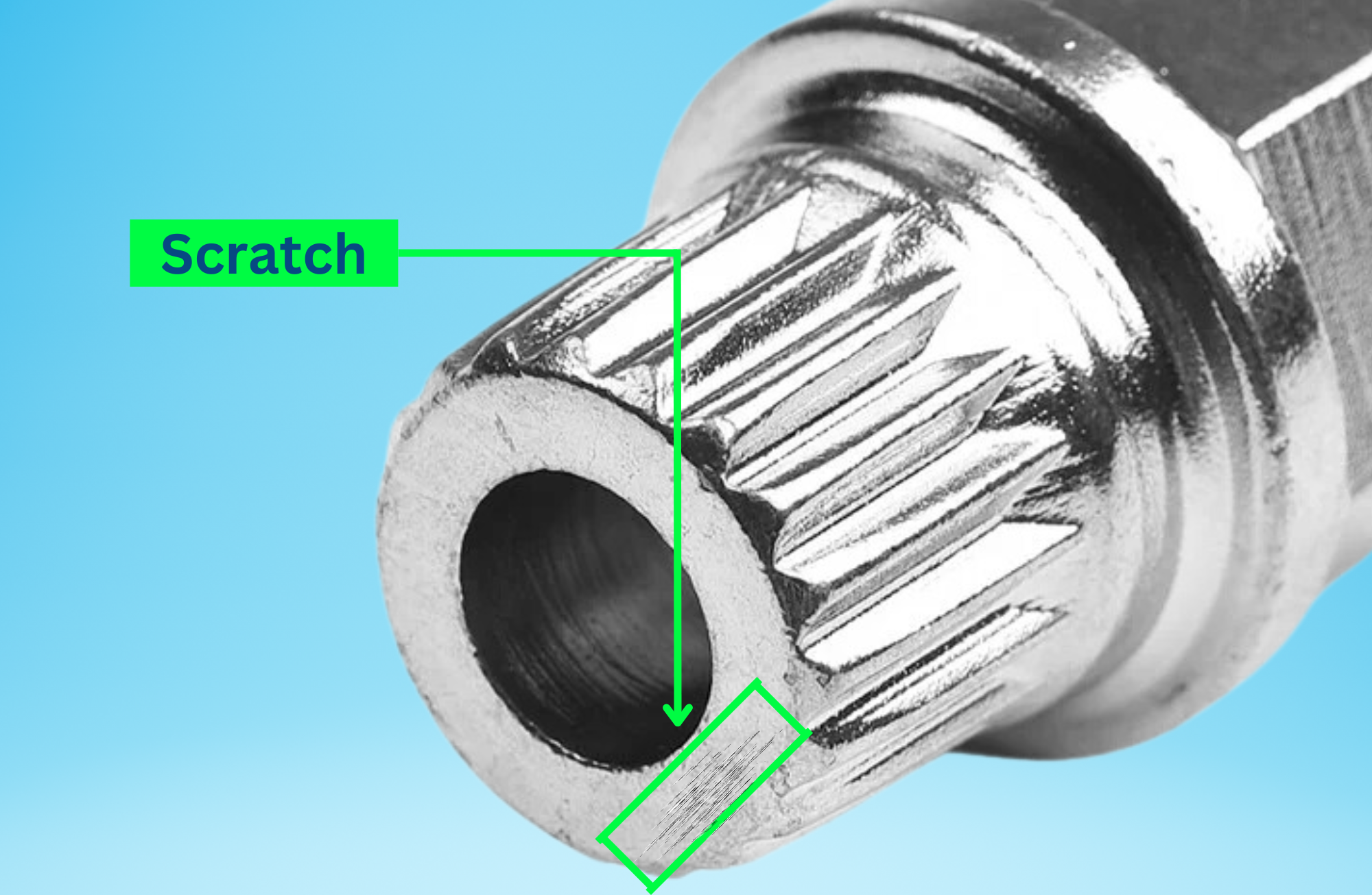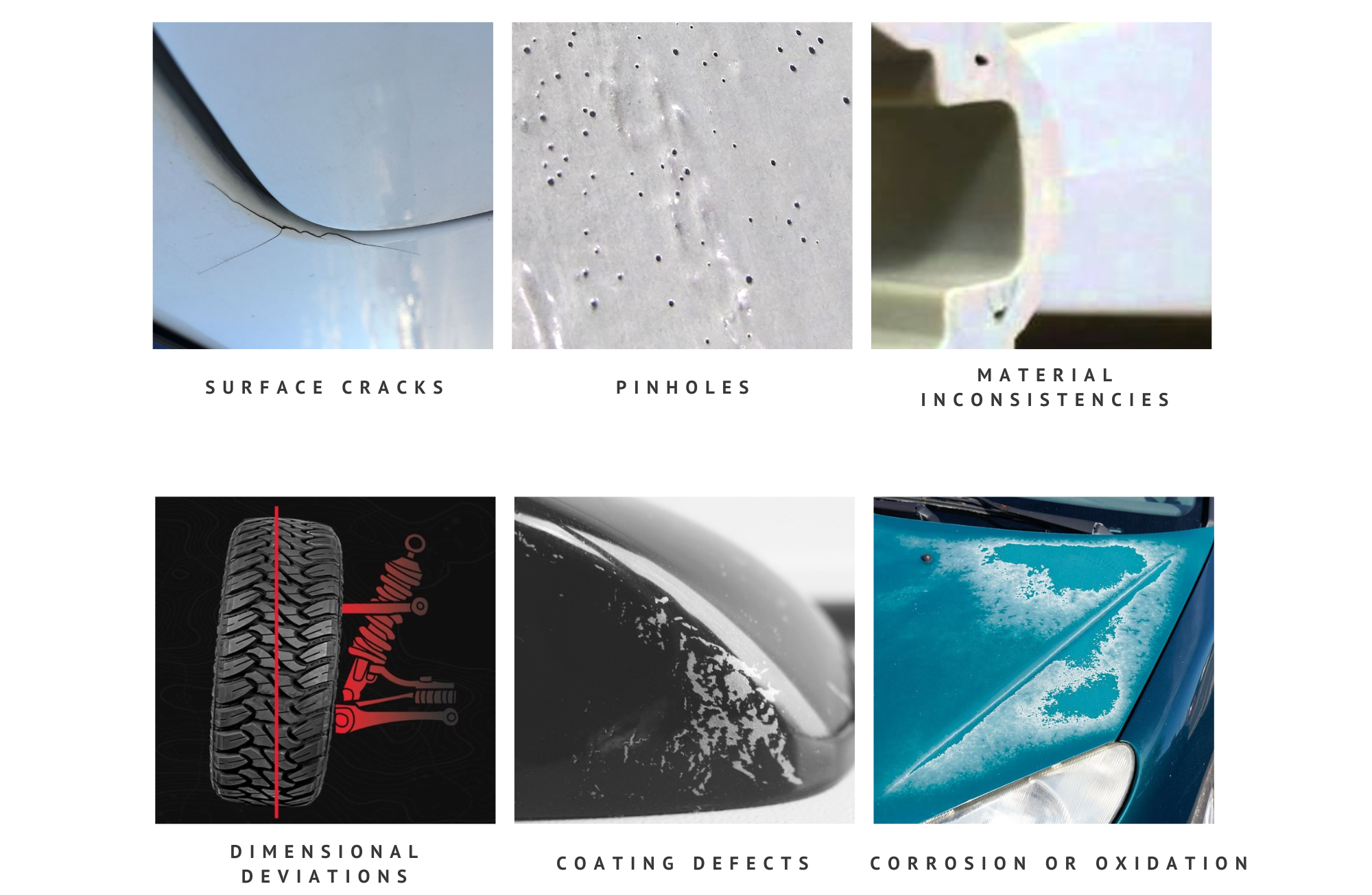Micron-Level Defect Detection in Automobile Parts
Published on: Dec 12, 2024

Written by: Soumen das
Micron-Level Defect Detection in Automobile Parts: Enhancing Quality Control with Advanced Technology
The automotive industry demands precision, safety, and reliability at every step of the manufacturing process. Even the smallest defects in automobile parts, often at the micron level, can compromise performance, safety, or aesthetics. Detecting these microscopic defects—such as surface cracks, pinholes, material inconsistencies, or dimensional deviations—is critical to maintaining the high standards required in modern vehicle manufacturing.

What are Micron-Level Defects?
Micron-level defects refer to anomalies or imperfections that are measured on a microscopic scale—typically less than 100 micrometers (µm). These defects are often invisible to the naked eye but can significantly impact the functionality, durability, or appearance of automobile components.
Common Micron-Level Defects in Automobile Parts
-
Surface Cracks:
-
Micro-cracks caused by stress, fatigue, or machining errors.
-
-
Pinholes:
-
Tiny holes or voids that can weaken structural integrity or affect coating performance.
-
-
Material Inconsistencies:
-
Variations in metal or composite structures, such as inclusions or voids.
-
-
Dimensional Deviations:
-
Microscopic errors in part dimensions that lead to misalignment or assembly issues.
-
-
Coating Defects:
-
Uneven coating thickness, cracks, or bubbles in painted or plated parts.
-
-
Corrosion or Oxidation:
-
Early-stage surface damage due to environmental exposure.
-

Why is Micron-Level Defect Detection Important?
1. Ensures Safety and Performance
Micron-level defects in critical components, such as engine parts, brakes, or steering systems, can lead to catastrophic failures, endangering lives. Detecting these defects ensures that every part meets safety and performance standards.
2. Enhances Product Quality
In a competitive market, maintaining high-quality standards is essential for brand reputation and customer satisfaction. Defect-free parts improve vehicle reliability and aesthetics.
3. Reduces Costs
Early detection of defects minimizes waste, rework, and warranty claims, reducing overall production costs.
4. Compliance with Standards
Automotive manufacturers must comply with stringent industry regulations and quality certifications, such as ISO/TS 16949. Micron-level defect detection ensures adherence to these standards.
5. Supports Advanced Manufacturing
As automotive designs become more complex, with lightweight materials and intricate geometries, the need for precision manufacturing and inspection has never been greater.
Challenges in Micron-Level Defect Detection
Detecting defects at the micron level is a complex task due to several challenges:
-
Tiny Size of Defects:
-
Micron-level defects are often smaller than the width of a human hair, requiring high-resolution imaging and advanced analysis tools.
-
-
Diverse Part Geometries:
-
Automotive parts come in various shapes, sizes, and materials, requiring adaptable inspection systems.
-
-
Reflective and Textured Surfaces:
-
Metal and coated surfaces can create glare or uneven lighting, making defects harder to detect.
-
-
High-Speed Production:
-
Modern automotive manufacturing lines operate at high speeds, demanding real-time inspection without slowing down production.
-
-
Material Variability:
-
Different materials, such as metals, plastics, and composites, require tailored inspection methods.
-
Technologies for Micron-Level Defect Detection
Modern technologies have made micron-level defect detection feasible and reliable. Here’s how they work:
1. High-Resolution Imaging Systems
-
Cameras with Micron-Scale Resolution:
High-resolution cameras capture detailed images of parts, enabling the detection of the smallest defects. -
Line-Scan Cameras:
Ideal for inspecting continuous or moving parts, these cameras capture images line by line, ensuring complete coverage.
2. AI-Powered Defect Detection
-
Customizable AI Models:
AI algorithms are trained on defect datasets, enabling them to identify and classify microscopic defects with precision. -
Real-Time Analysis:
AI processes images as they are captured, delivering instant defect identification and feedback. -
Defect Classification:
AI categorizes defects by size, type, and severity, helping manufacturers prioritize repairs or sorting.
3. Advanced Lighting Systems
-
Diffuse Lighting:
Reduces glare and ensures even illumination for reflective surfaces. -
Directional Lighting:
Enhances contrast, making fine defects more visible. -
Multi-Angle Illumination:
Captures defects from different angles, ensuring comprehensive coverage.
4. Integrated Motion Control Systems
-
Precision Conveyors:
Move parts consistently under imaging systems for uniform inspection. -
Robotic Arms:
Position cameras and lighting for complex geometries or hard-to-reach areas.
5. Automated Reporting and Feedback
-
Defect Mapping:
Reports highlight defect locations, enabling targeted repairs. -
Process Optimization:
Analytics identify patterns in defects, helping improve manufacturing processes.
Applications in the Automotive Industry
Micron-level defect detection is used across various automotive components and processes:
1. Engine and Powertrain Components:
-
Inspecting pistons, crankshafts, and camshafts for surface cracks or dimensional deviations.
2. Brake Systems:
-
Detecting micro-cracks or wear in brake discs and pads.
3. Body Panels and Coatings:
-
Ensuring smooth, defect-free finishes on exterior parts.
4. Transmission Systems:
-
Identifying flaws in gears, shafts, and bearings.
5. Electronics and Sensors:
-
Verifying the integrity of connectors, circuit boards, and housings.
Benefits of Automating Micron-Level Defect Detection
1. Unmatched Precision:
Detects defects invisible to the naked eye, ensuring the highest quality standards.
2. Increased Efficiency:
Automated systems inspect parts faster than manual methods, keeping up with high-speed production lines.
3. Consistency and Reliability:
Eliminates human error, delivering consistent and objective results.
4. Cost Savings:
Reduces waste, rework, and warranty claims, optimizing production costs.
5. Competitive Advantage:
Enhances product quality and reputation, differentiating manufacturers in a competitive market.
Electromechanical Systems for Complex Automobile Part Inspection
Automobile parts are highly diverse in size, shape, and dimension, ranging from intricate components like gears and valves to larger assemblies such as doors and chassis. Inspecting these complex shapes requires precision and adaptability, as every surface must be thoroughly examined to ensure complete quality control. At Intelgic, we integrate custom-designed electromechanical systems into our inspection solutions to handle this challenge effectively.
Custom Electromechanical Systems for Comprehensive Inspection
To achieve end-to-end inspection of complex parts, we often deploy electromechanical systems that move the parts in multiple directions during the imaging process. These systems ensure that every surface of the part is properly captured for defect detection.
- 360-Degree Imaging:
Our electromechanical systems enable parts to be rotated, tilted, or positioned precisely, allowing cameras and lighting systems to capture all surfaces and hidden areas. - Tailored Design:
At Intelgic, we understand that every part has unique inspection requirements. Our team carefully studies the part’s surfaces, dimensions, and inspection needs before designing and building custom electromechanical systems. - Seamless Integration:
These systems are seamlessly integrated with our imaging and AI-powered inspection technologies, ensuring synchronized movement and real-time analysis.
Applications in Diverse Automobile Parts
- Small Components:
For parts like gears, valves, and connectors, our systems ensure accurate positioning for detailed imaging of intricate surfaces. - Large Assemblies:
For larger parts such as doors, bonnets, and chassis, our systems facilitate controlled movement to inspect every side and edge.
Why Intelgic’s Electromechanical Systems Stand Out
- Precision and Reliability:
Designed for high-accuracy movement, ensuring consistent and reliable inspection results. - Customization:
Each system is built to meet the specific requirements of the part and inspection process. - Efficiency:
Automated movement reduces manual handling, speeding up the inspection process and increasing throughput. - Scalability:
Suitable for a wide range of part sizes and shapes, from small precision components to large structural assemblies.
Intelgic’s Expertise in Micron-Level Defect Detection
Intelgic specializes in designing and implementing custom Automated Optical Inspection (AOI) systems for micron-level defect detection in the automotive industry. Our solutions combine:
-
High-Resolution Imaging Technology: For capturing the finest details of automotive parts.
-
AI-Driven Analysis: Tailored algorithms for precise defect detection and classification.
-
Advanced Lighting Systems: Optimized for challenging surfaces and complex geometries.
-
Seamless Integration: Systems designed to integrate into existing production lines with minimal disruption.
Micron-level defect detection is no longer a luxury but a necessity in the automotive industry. As vehicles become more advanced and safety standards more stringent, manufacturers must adopt cutting-edge technologies to ensure the highest quality of their parts. Machine vision systems, powered by AI and high-resolution imaging, offer a reliable, efficient, and scalable solution for detecting microscopic defects.
Intelgic’s innovative solutions empower automotive manufacturers to achieve unmatched quality control, ensuring their parts meet the demands of modern vehicles and consumers. Contact Intelgic today to learn how our customized systems can revolutionize your defect detection processes.

